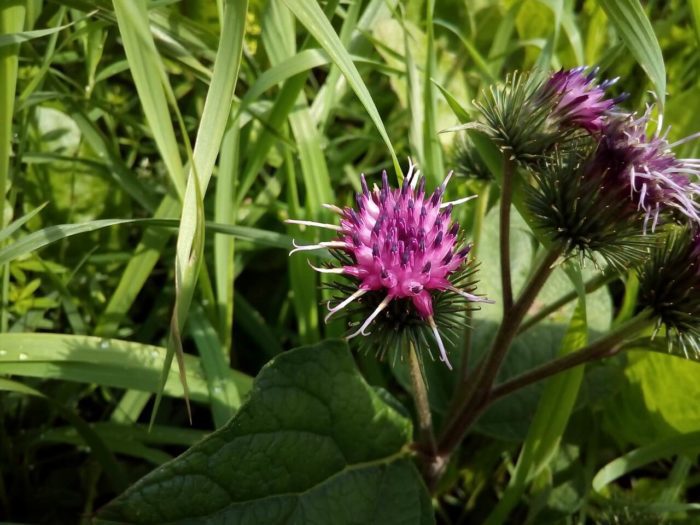Many people are already familiar with burdock. It’s tall and robust, but what makes it stand out the most is its pesky burrs that cling to our clothing after a walk on the roadside, in fields or pastures.
It certainly takes some patience to untangle one of the burrs from the dog’s thick coat. While burdock burrs can be annoying, they were the inspiration behind the 1941 patent of the velcro material by Swiss engineer, George de Mestral.
In North America, many view burdock (the two principal varieties are Arctium lappa or Arctium minus) as a useless weed. Well-established in the northern hemisphere, the biennial plant tends to be quite invasive in the garden. With elephant-ear leaves, a single plant can fruit 15,000 seeds and is challenging to uproot.
Burdock in the Kitchen
However, it is worth successfully uprooting. In Asia and Europe, burdock has been praised for centuries for its medicinal values and its dense-nutriment properties. In Japanese cuisine, burdock is known as Gobo root. In several Asian countries, the young burdock taproots are as standard in the marketplace as potatoes are in the west. The chewy, crunchy root has a high potassium content and is often sliced thinly, fried, and served as a chip-like snack. In Korea, a popular burdock root dish called Jorim is lightly braised in a sweetened soy sauce and a touch of honey.
Burdock root has a mild, sweet, and earthy taste, similar to Jerusalem artichoke, parsnip, or carrot. But the root may also have a slightly astringent or pungent flavor, making it a perfect substitute for coffee!
How to Make Burdock Root Coffee:
- In the fall, find a young burdock plant, dig up the root, wash it thoroughly, and chop it into small pieces.
- On a cookie sheet, bake the root pieces at 250°F for 45 minutes or until they are crispy and have turned a dark brown color.
- Finish the roasting on a low-broil setting for a couple of minutes. Be sure to remove the root pieces from the oven before they burn!
- Cool, then ground the small pieces in a coffee grinder.
- Store in an airtight container.
- Brew the burdock coffee the same way as regular coffee. Be warned that burdock root has a strong taste, so consider making the coffee weaker than usual.
- For a tasty herbal coffee recipe, add dandelion and chicory roots to the mixture.
Research has shown the roasting process increases the beneficial antioxidant components in burdock roots. The plant is rich in vitamins A, B, C, and E, as well as protein, iron, calcium, potassium, manganese, phosphorous, tannins, and fibers.
One of the superpowers of this weed is the inulin content in the root. Inulin is prebiotic, which means it can nourish the healthy bacteria in our intestines. Inulin can also assist with weight loss and the regulation of blood sugar levels. Enjoy all of the benefits of inulin by eating the burdock root or drinking it as a tea.
Burdock and Medicine
On top of being super nutritious, burdock has many medicinal virtues. Burdock can help bring balance to the cleansing systems of the body. In addition to supporting the kidneys, liver, the lymphatic system, and gastrointestinal tract, burdock root medicine promotes a healthy metabolism and is very beneficial to the skin.
It can help soothe many conditions, including eczema, psoriasis, dandruff, and acne. A strong infusion of the root can be used as a facial wash to rejuvenate the skin. In Europe, infused oil made with burdock root extract is sold as a scalp treatment to improve hair strength, shine and, volume, as well as to help combat hair loss.
Burdock’s anti-inflammatory properties help treat gout, osteoarthritis, and rheumatoid arthritis. Scientific studies also suggest the components of burdock roots have anti-cancer and anti-diabetic properties. Antimicrobial and antiviral, the plant also enhances the functions of the immune system.
The secret to unlocking all of the benefits of burdock is to use it frequently. The nourishing herb is slow and gentle and will work to its full potential if used for several weeks or months. Burdock is invaluable; if it invites itself into your garden, grab a shovel and harvest its benefits!
Disclaimer
As safe as the burdock plant is, it is essential to identify it correctly before foraging in the wild. Always consult a healthcare professional before taking any herbal allies. Pregnant or breastfeeding women should not take burdock. If taking insulin or oral medications to lower blood sugar, burdock may increase the potency of the medicine. The plant also has a high potassium concentration, so people on a potassium-restricted diet should check with a doctor before using burdock.
